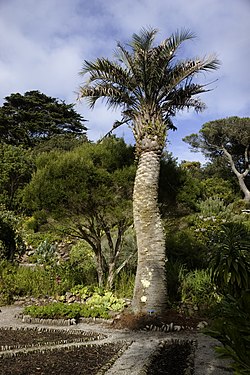Butia capitata
| Butia capitata subsp. var. | Pindo Palm, Jelly Palm | |||||||||||||||||||||||||||||||||||||||||||||||||||||||
|---|---|---|---|---|---|---|---|---|---|---|---|---|---|---|---|---|---|---|---|---|---|---|---|---|---|---|---|---|---|---|---|---|---|---|---|---|---|---|---|---|---|---|---|---|---|---|---|---|---|---|---|---|---|---|---|---|

|
|
| ||||||||||||||||||||||||||||||||||||||||||||||||||||||
| ||||||||||||||||||||||||||||||||||||||||||||||||||||||||
Butia capitata, also known as Pindo Palm or Jelly Palm, is a palm native to Brazil and Uruguay.[1] This palm grows up to 6m (exceptionally 8m) in a slow but steady manner. It is easily identifiable with beautiful feather palm pinnate leaves that arch inwards towards a thick stout trunk.
Cultivation
Propagation
Pests and diseases
Varieties
Gallery
-
photo 1
-
photo 2
-
photo 3
References
- ↑ "Taxon: Butia capitata (Mart.) Becc.". Germplasm Resources Information Network (GRIN). United States Department of Agriculture, Agricultural Research Service, Beltsville Area. Retrieved on 2010-04-24.
External links
- w:Butia capitata. Some of the material on this page may be from Wikipedia, under the Creative Commons license.
- Butia capitata QR Code (Size 50, 100, 200, 500)
